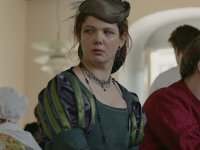“Gijs, they’re plotting a coup against you,” Anne said on day two of the Serious Larp we organized for 30 managers of the United Nations in Geneva.
A few months earlier, a director at the UN had asked us to design a training with the learning objectives of ‘showing more creativity’, ‘taking risks’, and ‘thinking from the end user’s perspective’. To achieve those goals, we created a Serious Larp. In other words, a larp where the first question you ask as an organizer is: “How do we ensure that the participants learn something from it?”
Serious Larps are one of the types of Serious Games that we design as ‘Live Action Learning’ (www.liveactionlearning.com). Larp is a form particularly suited for learning in social situations; about teamwork, navigating complex organizations, or as leadership training. Essentially, anything where a group of people tries to achieve something together. For some forms of training, larp is a better method than other methods of (role) playing because:
- All participants are involved simultaneously instead of watching.
- Making it safer and easier to participate
- You can mimic an entire organization or social system
- The learning effect is greater because your body is also involved, not just your mind
- Participants have much more influence on the story
- People can experiment more with learning points because they have an ‘alibi’ as they are playing a character.
Back to the United Nations: We started with an empty primary school and 30 heads of department from the Geneva office. Two days later, we ended up with 30 actively engaged ‘parents’, a coup, and an innovative new school. And the participants had come up with the coup entirely by themselves. How did we get there?
Setting up the playground and hiring teachers
In that empty primary school, with two acres of playground around it, we created a new reality. A reality in which 30 parents were opening a new, innovative school. The fictional parents were tired of the current system and wanted the ideal school for their children. We set a clear metaphor for their work and also chose a setting that is light-hearted & recognizable.

Teambuilding for the parents, while designing their own school. Photos by Philippe Hug & Gijs van Bilsen
In the story, the parents had to make difficult choices together about the new school they envisioned. Hiring teachers, deciding on a grading system, and the layout of the school and playground. All with the children’s interests in mind. Of course, the school inspection has requirements before the school can open. But how do you, as a parent, deal with those requirements if they don’t necessarily contribute to your child’s happiness?
30 children, specially designed for this scenario
Because ‘thinking from the end user’s perspective’ was the main learning objective, we wanted a compelling metaphor for that end user. So, we ‘designed’ 30 children. Of course, there were no real children present. We wrote 30 profiles, with photos and children’s drawings made by Artificial Intelligence. These fictional children were very different from each other. From clever inventors to mindful philosophers, from eco-warriors to new peace negotiators. In this way, we ensured different interests, symbolizing the interests in their work, without burdening the fiction with the real-life problems of the participants themselves.

One of the children (left) that we created, displayed on large posters throughout the building. Photos by Philippe Hug & Gijs van Bilsen
Everyone can participate in their own way
When we create such a Serious Game, especially if it’s a Serious Larp, we ensure that participants feel comfortable and can easily participate. We also always provide space to step out of the game and have roles in which people contribute to the training but play less of a character. So, we create a two-day event in which everyone can participate in their own way. You can dive in deep, but even if you don’t, you’ll still grasp the learning objective.
In extensive workshops, the participants got to know the fictional children we had prepared. The characters the participants played were the parents of those children. This means that the participants created their own character, deciding for themselves whether they wanted to resemble their child or play something else. We gave the participants a lot of freedom to decide how they want to participate. If you wanted to play a more extreme type, you could. If you wanted to play a character you could learn something from, that was possible and if you just wanted to be yourself with a different name, that was fine too.
Feel free to have fun with this
It’s important for people to give themselves permission to play. One of the most fun ways we help people with this is the prologue. In the prologue, we play out a piece of the game that the participants only need to watch while they are already in their role. The facilitators, actors, or a few pre-informed participants ensure that something interesting happens.
At the UN, we asked a few participants beforehand to actively participate in the prologue. In this case, we asked them to, in their role, put pressure on the ‘director’ (played by Gijs) during the opening speech. Suddenly, the rest of the room sees participants standing up and actively participating. It’s incredibly fun, especially when these participants also start ‘arguing’ among themselves. This gave a wonderful signal: ‘This is the level of participation that is completely okay. Feel free to have fun with this.’ In larp, some people use the term ‘herd competence’ for this.
What did it yield?
This scenario was created to challenge the participants in a fun and accessible way to be creative, take risks, and think from the end user’s perspective. During the extensive debrief at the end, it turned out that the participants had indeed picked up on these learning objectives. Other results we received from the participants were:
- They had a shared experience that they won’t forget quickly (they even organized an ingame reunion a few months later).
- They connected with each other on a much deeper level, making them more supportive of each other.
- They had fun playing out conflicts between characters. They said they learned that they could see a business conflict more as something you ‘play from your role or function’, while being able to see the person behind the role as more sympathetic.
- By playing innovative parents, they learned that they were more creative than they thought.
- They simply had a lot of fun together.
And what about that coup?
And what about that coup? Well, on day 2, the school inspection was scheduled to come. That meant there was still a lot to be done. On day 1, we, as facilitators, still helped to make it easy for people to get into the story. We did this as NPCs: the school principal and the gym teacher. On day 2, we wanted to put as much responsibility as possible on the participants by having the ‘director’ say, ‘I don’t see how we’re going to make it, I’m at my wit’s end.’
That worked well; the participants had already had fun in their roles and felt so involved with the school and the children. And as those parents, they were soon whispering amongst themselves, ‘Why is he even the director? Shouldn’t we hire a capable person for that?’. And so it happened that we, as game masters, found an organized coup in the coffee room, where Gijs was deposed as the fictional director, and the parents of the primary school ‘International School De Genève’ took matters into their own hands.
Of course, all with a big wink and a lot of laughter. Because nothing binds people together as much as having fun together.
We really want to promote larp further, also as a serious learning method. For more information about our activities, please contact: www.liveactionlearning.com
Cover photo: The main entrance of the school we were allowed to use. Photos by Philippe Hug & Gijs van Bilsen






